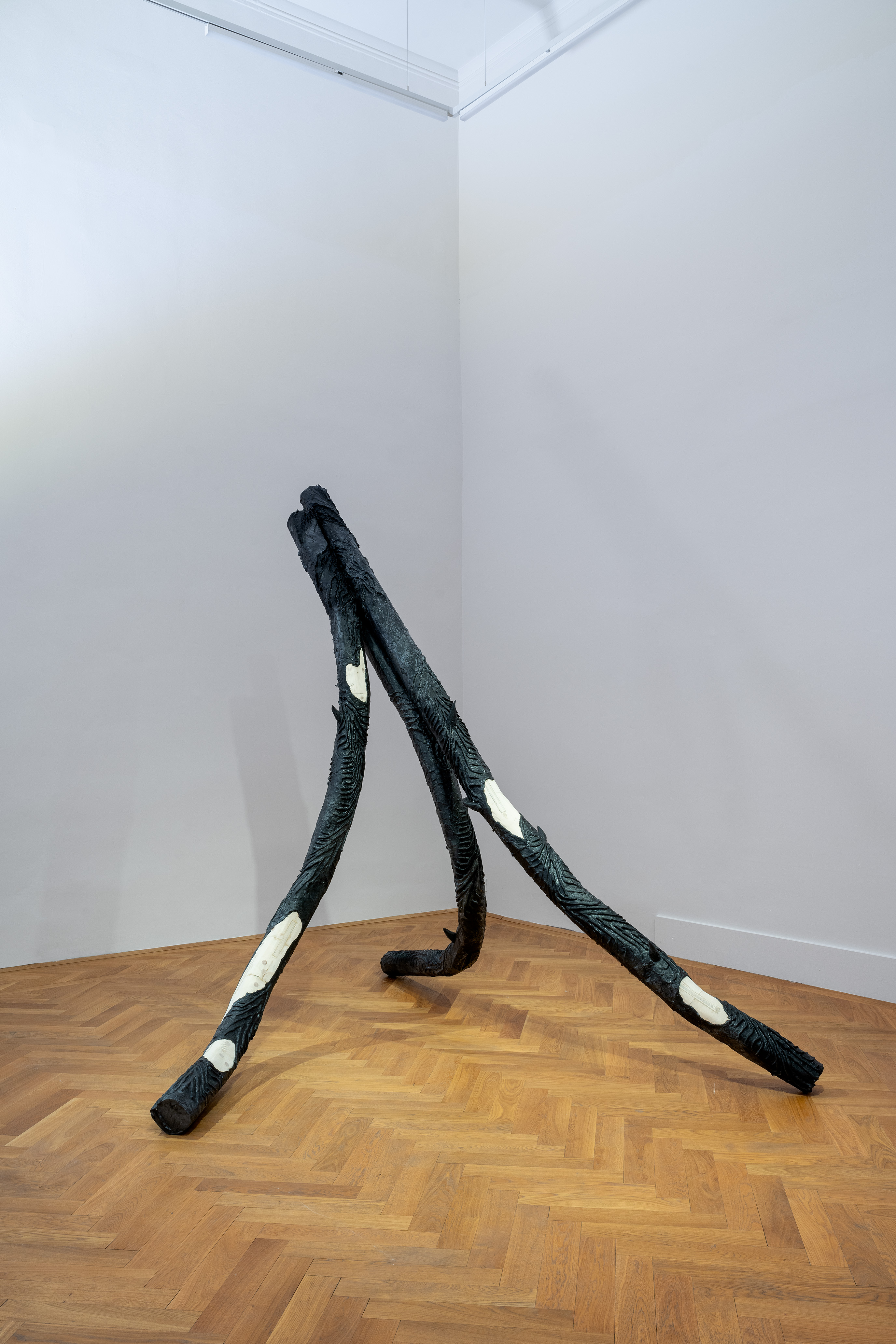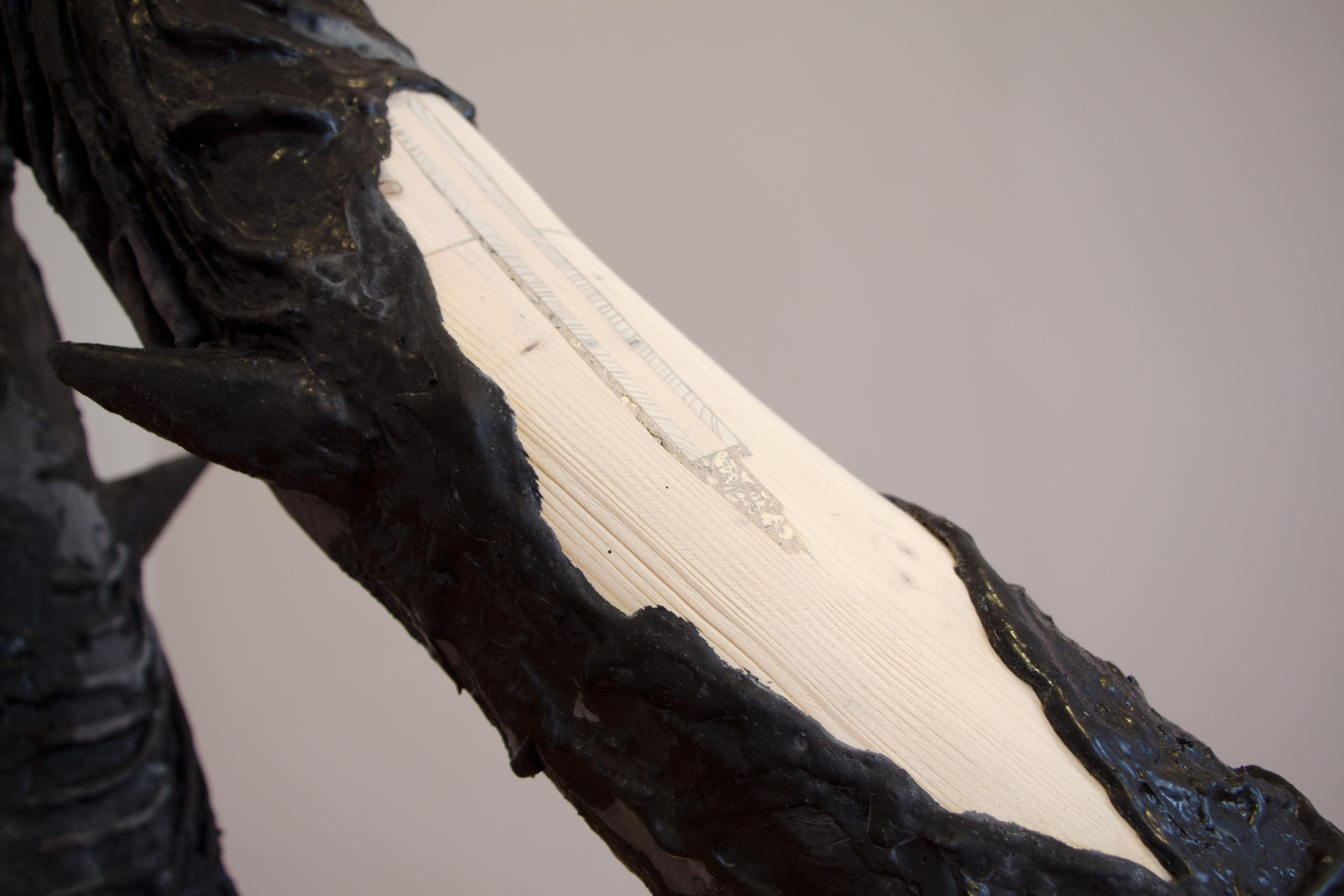



Photo: Johanna Pianka, Simon Veres, Gianna Virginia Prein
if ( ) {
} else {
270 x 240 x 240 cm
construction wood, natural rubber.
Exhibition view, Boderings Plants, Exhibit Galerie, Vienna, 2024
on brazil’s beaches lie rubber blocks
salty printed with product-of characters.
air-filled wheel rattling: a beginning of many
for the production of insulation material, uniforms,
tires pulled to smooth sandy soil
in front of borders.
muffled return of tropical boom
stranded from 6000 meters deep
from the wreck of the german blockade runner ms “rio grande”
from the tears of an old amazon basin tree – at least three time zones long –
deploring close quarters, left for other continents or
from the flood of a stolen seed wrapped in banana leaves that over- turned a monopoly:
raw rubber. the size of a suitcase. sunk in earlier january days
if not planted long ago in springy soil,
elastic, seeking self-deriving stability, as many are.
the sand, smoothed in a loop, for easier tracing of shoeprints before bor
ders.
Natural rubber extracted from the “tears of the tree” (“cao ochu”) originally comes from the Amazon basin of South America. Despite Brazil’s attempts to maintain this monopoly, the seeds of the rubber tree (Hevea brasiliensis) were smuggled out of the country in 1876 on unofficial orders from the English crown to be cultivated in the East Asian colonies. Only a few of these seeds survived the transport; they are the basis for all of today’s rubber trees worldwide.1
For Henry Ford, the founder of Ford Motors, rubber was the only raw material missing in his industrial complex. In order to be independent of expensive imports, Ford established two rubber tree plantations one after the other in the Brazilian state of Pará in 1928, Fordlândia and Belterra, which included a workers’ settlement with full infrastructure. Due to a fungus (Microcyclus ulei), the South American leaf-drop disease, the plantation trees didn’t survive the confinement of the monoculture. In addition, there were uprisings by the workers against the rules imposed on them, which ignored the reality on the ground. With the end of the Second World War and the advent of synthetic rubber, both towns were sold back to the Brazilian government in 1945 at a great loss. The large-scale plantation and industrialization of the rubber tree, and with it, Ford’s Americanizing Dream, failed on its continent of origin.2
Today, the rubber industry produces more than 850 types of silicone worldwide for mold making, insulating mats, films, gloves, etc. Originally found only in the Amazon basin, the rubber tree is now largely cultivated in Asia. The biggest customer, however, remains the automotive industry, which uses 70 percent of the world’s natural latex for the production of rubber tires.
1 _See“NaturalRubber,”inK.Matyjaszewski and M. Möller, eds. Polymer Science: A Comprehensive Reference, vol. 10, 281-291 (Amsterdam: Elsevier BV, 2013); and T.S. Suryanarayanan and J.L. Azevedo, “From forest to plantation: a brief history of the rubber tree,” Indian Journal of the History of Science, vol. 58, 2023, 74-78. https://doi. org/10.1007/s43539-023-00071-7).
2 _Kate Hawkey, “Humanity’s Relationship with Nature: Examples from History,” in History and the Climate Crisis: Environmental History in the Classroom (London: UCL Press, 2023), 51-76. JSTOR, https:// doi.org/10.2307/jj.4329862.10. Accessed September 5, 2023.
see booklet Bodering Plants